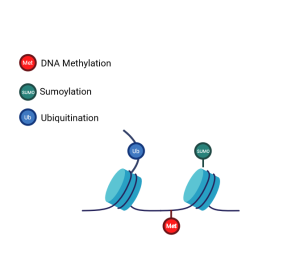4 Chromatin Organization
In this chapter, we will review chromosomes and the chromatin organization.
Learning Outcomes
By the end of this chapter, you will be able to
- Define the hierarchy of DNA structure.
- Describe the overall structure of the nucleosome.
- Compare and contrast the traits of heterochromatin and euchromatin.
- Identify the types of modifications of histones.
Understanding the structure of genetic material and how it is organized in the cell is crucial to understanding its relationship with gene expression. This structure and organization can also influence eukaryotic organisms’ development, functioning, and reproduction, as well as give insight into key cellular processes.
Chromosomes
Chromosomes: are thread-like structures located inside the nucleus of eukaryotic cells. A chromosome consists of protein and a single molecule of DNA, which serve as carriers of genetic information inherited from parents, encoding the distinct traits that characterize each organism.
An average human cell contains about 6.4 billion DNA base pairs divided among 46 chromosomes or 23 chromosomal pairs.

Reviewing the structure and organization of genetic material, let’s first begin with the DNA packaging in a chromosome by reviewing the hierarchical structure of DNA in the following interactive.
Adapted from “Deoxyribonucleic acid Structure”, by BioRender.com (2024).
Let’s now look closer at these levels of organization and their specific composition.
Nucleosome
A nucleosome is the basic unit of chromatin. It is a complex of DNA and histone proteins that make up the chromosomes. The chemical modification of nucleosomes plays an important role in gene expression and the overall chromatin structure, which we will review in the next chapter. First, let us review the structure of the core histones by completing the following interactive.
Learning Tip! Hover over the image for details on each image.
Adapted from “Histone Modification”, by BioRender.com (2024).
In Review
The following illustration reviews nucleosome and chromatin structure.
Chromatin
As we just reviewed, a nucleosome is the fundamental repeating unit of chromatin. Chromatin is the overall DNA structure in the cell nucleus and can exist in different states of compaction and organization. These differing states can be related to different gene expression levels and cellular requirements.
First, let’s look at the difference between heterochromatin and euchromatin by reviewing a microscopy H&E staining of heterochromatic versus euchromatic nuclei.
Learning Tip! Hover over the image for details on each image.
Now, let’s look at an illustration for comparison to review the differences between these two chromatin states.
Adapted from “Regulation of Transcription in Eukaryotic Cells”, by BioRender.com (2024).
Modifications of Chromatin
As mentioned, the state of chromatin can influence gene expression in the cell, which typically corresponds to chemical modifications. Chemical modifications of chromatin can influence transcription and impact other DNA processes such as repair, replication and recombination. Complete the following interactives to review the types of modifications.
Learning Tip! Click the + symbol in the top corner to look at the image closer.
Adapted from “Epigenetics and Gene Expression”, by BioRender.com (2024).
Additional modifications to histones are also possible, as shown below.


